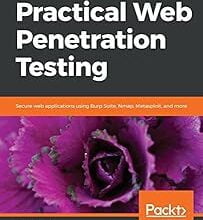
Rating: 4.6/5
Hello, keyboard warriors and digital defenders of the realm! Fasten your seat belts and brace yourselves for another high-octane dive into the intricate labyrinth of network security. Today, we’re flipping the pages of Richard Bejtlich’s much-acclaimed guidebook, The Practice of Network Security Monitoring: Understanding Incident Detection and Response, which has earned a dazzling 4.6 stars on our cybersecurity rating scale.
Bridging Theory and Practice
One of the standout features of this book is its hands-on, practical approach to network security. While many books dwell excessively on theories and methodologies, Bejtlich gets his hands dirty by providing meticulous guidance on setting up, running, and maintaining a Network Security Monitoring (NSM) operation. He couldn’t be more correct when he emphasizes, “In the cybersecurity world, practice is just as valuable as theory, if not more so.”
The Importance of Incident Response
Another strong suit of this literary masterpiece is its thorough treatment of Incident Response (IR). Bejtlich takes the reader on an enlightening journey through various real-world scenarios, demystifying how IR teams detect, investigate, and neutralize network intrusions. He astutely notes, “In the chess game of cybersecurity, your ability to respond effectively is your king.”
The Power of Open Source
Bejtlich’s focus on open-source tools is an invaluable addition to the book. The author offers detailed tutorials on using open-source stalwarts like Security Onion, Wireshark, and Snort. This approach not only makes the content accessible to those on a budget but also taps into the dynamism and community-driven development that open-source platforms offer. In Bejtlich’s words, “The power of open source in cybersecurity is its adaptability and community-driven development.”
A Few Shortcomings
No book is without its criticisms, and this one is no exception. For starters, Bejtlich leans heavily on Security Onion as his NSM platform of choice. Although Security Onion is a phenomenal tool, a more comprehensive survey of tools would have been welcomed. Secondly, while Bejtlich works hard to simplify complex ideas, the book’s content can be a bit overwhelming for complete novices in the field. The author acknowledges this when he states, “To become an expert in cybersecurity, one must embrace the complexity and strive for understanding.”
Skill Acquisition and Growth
When it comes to skill progression, “The Practice of Network Security Monitoring” covers the full spectrum—from novice to expert. Beginners will find the foundational concepts enlightening, whereas competent readers will appreciate the deeper dives into more complex subject matter. Finally, experts in the field will find intricate case studies that can add depth to their existing body of knowledge.
Practical Examples from the Book
One of the strongest elements of this book is its focus on real-world examples. Two key examples from the book illustrate this:
- The Use of Security Onion: In the early chapters, Bejtlich provides a full walkthrough of setting up Security Onion, from installation to data visualization. He explores how this free software suite can serve as a robust platform for NSM, even in enterprise environments.
- Investigating a Real-world Attack: In one of the later chapters, Bejtlich presents a case study that involves investigating a SQL injection attack. Through this case study, readers can gain a practical understanding of the IR process, from the initial alert to the final mitigation measures.
Secondly, the book features numerous practical scenarios and examples. Sanders has taken the pain to provide ample illustrations of where Wireshark, a widely used network protocol analyzer, can be put to use in solving real-world problems.
Practical Scenarios and Examples from the Book
- Identifying Malicious Traffic: One of the most useful real-world applications explained in the book involves using Wireshark to identify malicious traffic. Sanders walks you through the process of capturing and analyzing packets that contain signs of a malware infection. By following his step-by-step instructions, you can better understand how to spot irregularities in your network and take appropriate action.
- Troubleshooting Network Latency: Another great example deals with network latency issues. Sanders explains how to utilize Wireshark to capture packets and measure network response times, thereby allowing you to pinpoint the root cause of latency and solve it. This exercise is particularly useful for system administrators who need to ensure optimal network performance.
- VoIP Analysis: The book also delves into more specialized topics, like analyzing Voice over IP (VoIP) packets. Sanders shows how you can use Wireshark to troubleshoot poor call quality issues by examining the packet data for jitter, latency, and packet loss. This example is incredibly useful for businesses relying on VoIP for their communication needs.
In his words, ‘A theory is just a theory unless put into practice.’
In Summary
To conclude, The Practice of Network Security Monitoring is a must-read for anyone seriously considering diving deep into the waters of network security and incident response. As Bejtlich reminds us, “Mastering network security is a journey, and every incident is a learning opportunity.”
So, pour yourself a tall glass of your favorite energy drink, recline in your comfortable chair, and immerse yourself in this enlightening tome. As we venture forth into the complex world of network security, let’s remember Bejtlich’s sage advice: “The best defense is a good offense, and in cybersecurity, that offense is knowledge.”
Gear up, digital defenders! The road to becoming a cybersecurity virtuoso has never been this exciting. Let’s embark on this remarkable journey, learning and honing our skills one chapter at a time.




